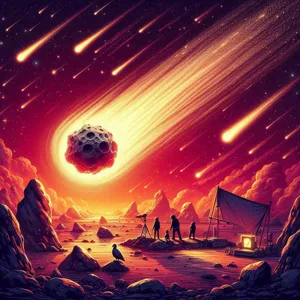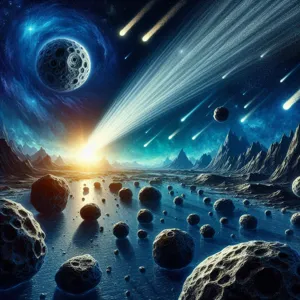As we gaze into the vast expanse of our solar system, two celestial bodies often capture our imagination: comets and asteroids.
While both are remnants from the early days of our cosmic neighborhood, they possess distinct characteristics and intriguing histories that set them apart. Comets, with their majestic tails and icy compositions, evoke images of cosmic wanderers gliding through the void, while asteroids, rocky and resilient, serve as reminders of the building blocks that formed our planet. In this blog post, we will delve into the fascinating differences between these two astronomical entities, exploring their origins, compositions, and roles within the solar system. Join us on this journey as we unravel the mysteries behind comets and asteroids, shedding light on their significance in the grand tapestry of our celestial home.
1. Introduction to Comets and Asteroids

In the vast expanse of our solar system, comets and asteroids are two fascinating celestial bodies that capture the imagination of astronomers and stargazers alike. Though they both roam the cosmic highways, their origins, compositions, and behaviors set them apart in remarkable ways.
Comets, often referred to as “dirty snowballs,” are icy bodies that originate from the outer reaches of the solar system, primarily from the Kuiper Belt and the Oort Cloud. Composed of frozen gases, dust, and rocky material, comets exhibit a distinctive glowing coma and a spectacular tail when they approach the sun. This tail, created by the sublimation of ice and the solar wind, can stretch for millions of kilometers, creating a breathtaking display that has captivated humanity for centuries. The sight of a comet streaking across the night sky has often been associated with both wonder and foreboding, as these celestial visitors have been linked to significant historical events and changes on Earth.
In contrast, asteroids are primarily rocky remnants from the early solar system, formed about 4.6 billion years ago. Most are found in the asteroid belt between Mars and Jupiter, where they orbit the sun without the dramatic tails associated with comets. Composed mainly of metals and rock, asteroids vary greatly in size, shape, and composition, with some being mere boulders, while others can be hundreds of kilometers across. These ancient objects provide valuable insights into the building blocks of our solar system and the conditions that prevailed during its formation.
Understanding the differences and similarities between comets and asteroids not only enriches our knowledge of these celestial phenomena but also offers a glimpse into the dynamic processes that shape our cosmic neighborhood. As we delve deeper into their mysteries, we uncover the stories etched in their surfaces and the potential implications for our planet’s past, present, and future. Join us as we embark on a journey to explore the captivating world of comets and asteroids, unraveling the secrets they hold within the vast tapestry of our solar system.
2. Defining Comets: Characteristics and Composition
Comets, often referred to as the “dirty snowballs” of the solar system, are fascinating celestial objects that captivate our imagination with their ethereal beauty and striking tails. At their core, comets are composed of a mixture of ice, dust, gas, and rocky materials, which together create a unique and dynamic structure. When these icy bodies venture close to the Sun, the heat causes their ices to vaporize, producing a glowing coma—an expansive, nebulous envelope that can extend for thousands of kilometers.
The most distinguishing characteristic of a comet is its spectacular tail, which can stretch millions of kilometers into space. This tail is formed as solar radiation and the solar wind push the released gas and dust away from the comet’s nucleus, creating a dazzling display that often captivates observers on Earth. Comets can have two types of tails: the ion tail, which is made of charged particles and points directly away from the Sun, and the dust tail, which follows the comet’s orbit and can appear more curved.
Comets are categorized into two main types based on their orbital periods: short-period comets, which take less than 200 years to complete an orbit around the Sun, and long-period comets, which can take thousands to millions of years. Famous examples of short-period comets include Halley’s Comet, which graces our skies approximately every 76 years, while long-period comets, such as Comet Hale-Bopp, can return to the inner solar system after centuries of absence.
The study of comets not only helps us understand the origins of our solar system but also provides clues about the primordial materials that existed during its formation. By analyzing the composition of comets, scientists gain insights into the chemical building blocks of life and the conditions that may have led to the emergence of life on Earth. Whether observed in the night sky or studied through advanced telescopes and space missions, comets remain one of the most intriguing subjects in the ongoing quest to unravel the mysteries of our cosmic neighborhood.
3. Defining Asteroids: Characteristics and Composition

Asteroids, often referred to as “minor planets” or “planetoids,” are fascinating celestial bodies that populate the vast expanse of our solar system. Primarily found in the asteroid belt between Mars and Jupiter, these rocky remnants are leftovers from the early solar system, believed to be composed of the primordial material that never coalesced into planets.
One of the defining characteristics of asteroids is their rocky composition, which distinguishes them from their icy counterparts, the comets. Asteroids are primarily made up of minerals and metals, including iron, nickel, and silicate, giving them a solid and often irregular shape. Their surfaces can vary significantly, with some displaying craters, grooves, and even mountains, while others appear smooth and featureless. The size of asteroids can also vary dramatically, ranging from a few meters to hundreds of kilometers in diameter. The largest known asteroid, Ceres, is classified as a dwarf planet and measures about 940 kilometers across.
Asteroids are categorized into different types based on their composition. The three main categories are C-type (carbonaceous), S-type (silicaceous), and M-type (metallic). C-type asteroids are the most common and are rich in carbon, making them dark and difficult to observe. S-type asteroids are composed primarily of silicate minerals and metals, giving them a brighter appearance. M-type asteroids are metallic and often contain significant amounts of iron and nickel, making them of particular interest for mining in the future.
In addition to their composition, asteroids exhibit unique orbits and can sometimes be found in resonance with the planets. Some have even been identified as potential Earth impactors, sparking interest in planetary defense strategies to mitigate any potential threat they may pose. As we continue to study asteroids through missions like NASA’s OSIRIS-REx and Japan’s Hayabusa2, we uncover more about their origin, evolution, and the role they play in the broader context of our solar system’s history. Understanding asteroids not only helps us grasp the formation of our celestial neighborhood but also aids in our efforts to defend our planet from potential impacts, making them a crucial subject of scientific inquiry.
4. The Origins of Comets and Asteroids
To truly appreciate the distinction between comets and asteroids, one must delve into their origins, which are as fascinating as they are complex. Both celestial bodies are remnants from the early solar system, but their paths diverged significantly in terms of formation and composition.
Comets are often described as the “dirty snowballs” of the cosmos. They originate from the cold, outer regions of the solar system, primarily from two key areas: the Kuiper Belt and the Oort Cloud. The Kuiper Belt, located beyond the orbit of Neptune, is home to many icy bodies that can become comets when they are nudged into the inner solar system by gravitational interactions. The Oort Cloud, a hypothetical spherical shell of icy objects surrounding the solar system at a far greater distance, is thought to be the source of long-period comets that take thousands of years to complete their orbits. When comets venture close to the Sun, the heat vaporizes their icy cores, creating spectacular tails of gas and dust that stretch for millions of kilometers, captivating astronomers and stargazers alike.
In contrast, asteroids are primarily found in the asteroid belt, a region of space situated between the orbits of Mars and Jupiter. These rocky remnants are thought to be the building blocks of the planets, left over from the early solar system’s formation around 4.6 billion years ago. Unlike comets, asteroids are composed mainly of rock and metal, with very little ice. Their formation was influenced by the gravitational forces of nearby planets, especially Jupiter, which prevented these materials from coalescing into a larger planetary body. As a result, asteroids come in a variety of shapes and sizes, from small boulders to dwarf planet-sized objects, each holding clues about the solar system’s history.
Understanding the origins of comets and asteroids not only highlights their differences but also underscores their significance in the broader context of our solar system. These ancient relics serve as time capsules, preserving the conditions of the early solar system and offering insights into the processes that led to the formation of planets, moons, and even life itself. As we continue to explore these celestial bodies through space missions and telescopic observations, we unravel more of the mysteries that lie within the cosmos, shedding light on our origins and the ever-evolving nature of our universe.
5. Orbits and Trajectories: How They Move in Space

When it comes to understanding the cosmos, the orbits and trajectories of comets and asteroids reveal fascinating insights into their nature and behavior. While both celestial bodies travel through the vast expanse of our solar system, their paths and patterns of movement are quite distinct, shaped by their unique characteristics.
**Comets**, often referred to as “dirty snowballs,” are primarily composed of ice, dust, and rocky materials. Their orbits are typically elongated and eccentric, taking them on a journey that can span from the inner solar system to the far reaches of the outer solar system. As a comet approaches the Sun, the heat causes its icy core to vaporize, creating a stunning tail that stretches millions of kilometers into space. This tail always points away from the Sun, a phenomenon driven by solar wind and radiation pressure. The journey of a comet can be both dramatic and unpredictable; some comets, like Halley’s Comet, have well-documented orbits, returning to the inner solar system every 76 years, while others may have much longer orbits or even be one-time visitors.
In contrast, **asteroids** are primarily composed of rock and metal and tend to have more circular orbits, often found within the asteroid belt that lies between Mars and Jupiter. Their movement is generally more stable, with many asteroids following predictable paths that can last for millions or even billions of years. Unlike comets, asteroids do not exhibit tails since they lack the volatile materials that vaporize in proximity to the Sun. However, some asteroids can be nudged from their orbits due to gravitational interactions with planets or other celestial bodies, leading them into the inner solar system where they might become a potential threat to Earth.
The study of these orbits and trajectories not only helps astronomers classify and understand these celestial bodies but also informs us about the early solar system’s conditions and the formation of planets. By analyzing the paths of comets and asteroids, scientists can glean important information about the history of our solar system and the processes that have shaped it over billions of years. As we continue to explore the mysteries of space, keeping track of where these travelers are headed remains an essential endeavor in unraveling the secrets of our cosmic neighborhood.
6. Notable Comets in History
Throughout history, comets have captured the human imagination, often seen as celestial harbingers of change and transformation. Their fleeting appearances in the night sky have woven themselves into the fabric of cultural lore, inspiring awe and sometimes fear. Here are some of the most notable comets that have graced our skies, leaving lasting impressions on our collective consciousness.
One of the most famous is Halley’s Comet, which has been observed for over two millennia. It is visible from Earth approximately every 76 years, with its most recent appearance in 1986. Halley’s Comet has been documented in various historical texts, including the Bayeux Tapestry, which depicts its appearance in 1066, right before the Norman Conquest of England. Its arrival was interpreted as an omen, and to this day, it remains a symbol of the unpredictable nature of the cosmos.
Another significant comet is Comet Hale-Bopp, which thrilled skywatchers in the late 1990s. Discovered independently by Alan Hale and Thomas Bopp in 1995, it became one of the brightest comets of the 20th century, visible to the naked eye for an astonishing 18 months. Its unusual brightness and long tail captivated millions, leading to a surge in interest in amateur astronomy.
Then there’s Comet Shoemaker-Levy 9, which made history in 1994 when it collided with Jupiter. This spectacular event was the first direct observation of a collision between two solar system bodies, and the impacts were so large they created massive fireballs and dark scars on the gas giant’s surface. The event was a landmark moment for astronomers and showcased the dynamic and sometimes violent nature of our solar system.
Lastly, we can’t forget about Comet NEOWISE, which made headlines in 2020 as it dazzled observers around the world with its brilliant tail. Its unexpected brightness and easy visibility made it a favorite for stargazers during a summer when many were looking for a glimmer of hope amid global uncertainties.
These comets not only serve as reminders of the vastness and unpredictability of our solar system but also as symbols of human curiosity and our desire to comprehend the universe. Their stories remind us of our place in the cosmos and the wonders that await us beyond our blue planet.
7. Famous Asteroids and Their Impact on Earth

When we think of asteroids, our minds often drift to images of colossal rocks hurtling through the vastness of space, but these celestial bodies have had remarkable influence on our planet’s history. Several infamous asteroids have not only shaped the geological landscape of Earth but have also played pivotal roles in the evolution of life itself.
One of the most renowned asteroids is **Bennu**, a near-Earth object that has captured the attention of scientists and space enthusiasts alike. With a diameter of approximately 1,600 feet, Bennu is not only fascinating for its structure but also for its potential impact on Earth. Discovered in 1999, this asteroid is on a trajectory that could bring it close to our planet in the late 22nd century. NASA’s OSIRIS-REx mission, which successfully collected samples from Bennu in 2020, aims to reveal clues about the origins of the solar system and the building blocks of life.
Another prominent asteroid in our cosmic narrative is **Apophis**. Initially discovered in 2004, this asteroid, measuring around 1,200 feet across, made headlines due to early predictions that it could collide with Earth in 2029. Although subsequent observations have ruled out a direct impact, Apophis remains an object of interest, reminding us of the potential threats posed by these space rocks and the importance of tracking their paths.
Then there’s the infamous **Chicxulub asteroid**, a giant asteroid that struck Earth around 66 million years ago, leading to one of the most significant mass extinctions in Earth’s history. The impact created a crater over 150 kilometers wide off the coast of Mexico and is largely believed to have contributed to the demise of the dinosaurs. This event underscores the profound impact that asteroids can have—not just as distant objects in the sky, but as agents of change that can alter the course of life on our planet.
In exploring the stories behind these famous asteroids, we are reminded of the dynamic and often unpredictable nature of our solar system. As we continue to study these celestial bodies, we not only deepen our understanding of cosmic mechanics but also gain insight into the past, present, and future of life on Earth. The tales of these asteroids serve as a powerful reminder of the interconnectedness of our universe, where every rock, no matter how small, holds the potential to make an enormous impact.
8. The Role of Comets and Asteroids in the Solar System’s Formation
The formation of our solar system is a tale of cosmic chaos, and at the heart of this narrative lie comets and asteroids—two celestial bodies that played pivotal roles in shaping the worlds we know today. These remnants of the early solar system are essentially time capsules, preserving clues about the conditions during its tumultuous birth over 4.5 billion years ago.
Comets, often described as “dirty snowballs,” are composed of ice, dust, and rocky material. As they traverse the solar system, they develop glowing comas and spectacular tails when they approach the Sun, shedding light on their composition and volatility. Scientists believe that comets may have delivered essential water and organic compounds to the inner planets, including Earth. This delivery could have been crucial for the emergence of life, making comets not just cosmic wanderers but also potential harbingers of life itself.
On the other hand, asteroids are primarily found in the asteroid belt between Mars and Jupiter. Composed mainly of rock and metal, these remnants of planetesimals are considered the building blocks of the planets. Their study aids scientists in understanding the processes that led to planetary formation and the differentiation of materials within the solar system. The collision of asteroids has also had dramatic effects on the planets, with theories suggesting that impacts from asteroids have caused mass extinctions on Earth, including the one that wiped out the dinosaurs.
Together, comets and asteroids provide invaluable insights into the solar system’s history. By studying their trajectories, compositions, and the interactions they have experienced over billions of years, astronomers can piece together the puzzle of how our solar system formed and evolved. As we continue to explore these celestial objects, we not only learn more about our cosmic neighborhood but also about the fundamental processes that govern planetary systems throughout the universe.
9. The Science of Comet Tails: What They Reveal
Comets are some of the most captivating celestial objects in our solar system, and their tails are a mesmerizing spectacle that tell us much about their composition and behavior. A comet’s tail forms when it approaches the Sun, and the intense heat causes the comet’s icy nucleus to sublimate, releasing gas and dust into space. This process creates a stunning display that can stretch for millions of kilometers, often glowing brightly against the dark canvas of the night sky.
There are two distinct types of tails that comets typically produce: the ion tail and the dust tail. The ion tail is composed of charged particles that are pushed away from the Sun by solar wind, forming a straight, narrow plume that always points directly away from the Sun. In contrast, the dust tail is broader and more curved, reflecting the sunlight and consisting of larger, heavier particles that are less affected by solar wind. The interplay between these two tails creates a dynamic visual representation of a comet’s journey through the solar system.
Scientists study the composition and behavior of comet tails to glean insights about the early solar system. The materials found in comet tails can offer clues about the building blocks of planets and the conditions that existed during their formation. For instance, the presence of certain gases can indicate the temperature and pressure conditions present in the primordial solar nebula. Additionally, by analyzing the chemical makeup of comet tails, researchers can explore the potential for organic compounds to exist beyond Earth, feeding into the ongoing debate about the origins of life.
Furthermore, observing how tails evolve as a comet travels closer to the Sun can provide critical information about its structure and stability. Some comets, like Comet Hale-Bopp, exhibit particularly impressive tails that can last for extended periods, while others may disintegrate or fade quickly. Understanding these phenomena not only enhances our knowledge of comets themselves but also enriches our understanding of the broader workings of our solar system.
In essence, the science of comet tails is a window into the past, illuminating the complex processes that have shaped our celestial neighborhood. As we continue to unravel these mysteries, we come closer to understanding the origins of our solar system and the cosmic forces that govern the dance of celestial bodies.
10. Asteroids as Potential Resources for Future Exploration
As humanity looks to the stars for future exploration, asteroids are emerging as more than just celestial rocks; they are potential treasure troves of resources waiting to be unlocked. These ancient remnants from the solar system’s formation hold a wealth of materials that could be invaluable for both scientific research and practical applications.
Asteroids are primarily composed of metals, such as nickel, iron, and cobalt, as well as essential minerals and water. The prospect of mining these resources is not merely speculative. NASA and private companies alike are actively researching and developing technologies to access and utilize these distant bodies. For instance, the water found on asteroids could be transformed into hydrogen and oxygen, providing fuel for spacecraft and supporting life for long-duration missions beyond Earth.
Moreover, the metals extracted from asteroids could help alleviate resource scarcity on our planet. With Earth’s growing population and increasing demand for metals, mining asteroids could offer a sustainable solution for manufacturing and construction industries. Imagine a future where spacecraft can be built using materials sourced directly from the cosmos, significantly reducing the costs and risks associated with transporting resources from Earth.
As we continue to send robotic missions to explore these celestial bodies, we gain unprecedented insights into their composition and structure. Each mission brings us closer to understanding how we can harness the resources of asteroids, transforming them from distant objects of study into valuable assets for humanity’s journey into space. As the line between science fiction and reality blurs, the exploration of asteroids presents not just a frontier for discovery but also a pathway to sustainable living and expansion beyond our planet.
11. The Threat of Near-Earth Objects (NEOs)
The universe is a vast and dynamic place, and within it, the presence of Near-Earth Objects (NEOs) poses a unique and sometimes alarming threat to our planet. NEOs can be categorized into two main groups: asteroids and comets, both of which have their origins in the early solar system. Asteroids, primarily rocky and metallic bodies, are often found in the asteroid belt between Mars and Jupiter, while comets, rich in ice and volatile compounds, tend to originate from the colder regions beyond Neptune.
As astronomers meticulously track these celestial wanderers, concerns arise regarding their potential impact on Earth. NEOs that come within 1.3 astronomical units (AU) of our planet are classified as potentially hazardous. The very notion of an asteroid or comet colliding with Earth conjures images of cataclysmic events, reminiscent of the dinosaur extinction caused by a massive impact some 66 million years ago. While such large-scale collisions are rare, the threat remains ever-present, with smaller NEOs coming closer to Earth more frequently than we might realize.
Monitoring and tracking these objects is a priority for space agencies worldwide, leading to advancements in detection technologies. Programs like NASA’s Near-Earth Object Observations (NEOO) aim to identify and characterize these wandering bodies, assessing their orbits and potential risks. Each discovery adds a piece to the puzzle, enabling scientists to predict the trajectories of these celestial travelers and devise strategies for planetary defense.
Public awareness surrounding NEOs is crucial. By understanding their nature and the risks they pose, we can foster a culture of preparedness and scientific inquiry. Whether through educational initiatives or outreach programs, engaging the public with the wonders of our solar system can inspire a collective effort to protect our planet from potential threats. As we continue to unravel the mysteries of comets and asteroids, one thing remains clear: the cosmos is as unpredictable as it is fascinating, and vigilance is our best defense against the unknown.
12. The Search for Comets and Asteroids: Tools and Techniques
The search for comets and asteroids is a fascinating endeavor that combines the skills of astronomers, engineers, and technology, painting a captivating picture of our solar system’s dynamic past and future. To uncover these celestial wanderers, scientists employ a variety of sophisticated tools and techniques, each tailored to the unique characteristics of these bodies.
One of the primary instruments used in this quest is the telescope. Ground-based observatories, such as the Mauna Kea Observatories in Hawaii or the Palomar Observatory in California, utilize powerful optical and infrared telescopes to scan the night sky. These telescopes capture light from distant objects, allowing astronomers to observe the faint glimmers of comets and asteroids. Additionally, space-based telescopes like the Hubble Space Telescope provide an unobstructed view of the cosmos, free from the distortions of Earth’s atmosphere, enhancing the chances of spotting elusive celestial objects.
In recent years, advancements in technology have led to the deployment of specialized surveys designed specifically for discovering new asteroids and comets. Programs like the Pan-STARRS (Panoramic Survey Telescope and Rapid Response System) and the Catalina Sky Survey utilize wide-field cameras to photograph large sections of the sky repeatedly, identifying moving objects against the backdrop of stars. These surveys can detect even the faintest of comets and asteroids, significantly expanding our knowledge of these bodies.
Data analysis plays a crucial role in the search as well. Using sophisticated algorithms and software, astronomers analyze vast amounts of data from these surveys, sifting through images to identify potential candidates. Machine learning techniques are increasingly being employed to improve the detection rates, allowing computers to recognize patterns that human eyes might miss.
Moreover, space missions have become indispensable tools in our quest to understand comets and asteroids. For example, NASA’s NEOWISE mission has been instrumental in tracking near-Earth objects, while the European Space Agency’s Rosetta mission provided unprecedented insights into the composition of comet 67P/Churyumov-Gerasimenko. These missions not only help in identifying and tracking these celestial bodies but also allow scientists to study their physical properties up close, further unraveling the mysteries surrounding their origins and evolution.
In summary, the search for comets and asteroids is a multi-faceted endeavor that relies on cutting-edge technology and innovative techniques. From ground-based telescopes to advanced space missions, each tool contributes to our understanding of these fascinating objects, helping us piece together the story of our solar system and its countless wonders.
13. Recent Discoveries and Research in Comet and Asteroid Studies
In recent years, the field of comet and asteroid studies has experienced a renaissance, fueled by advancements in technology and a renewed interest in understanding these celestial bodies that roam our solar system. Groundbreaking missions, telescopic observations, and innovative research techniques have unveiled new insights into the origins, compositions, and potential risks associated with these cosmic wanderers.
One of the most notable discoveries came from NASA’s OSIRIS-REx mission, which successfully collected samples from the near-Earth asteroid Bennu in 2020. This mission not only provided scientists with unprecedented material to analyze, shedding light on the building blocks of our solar system but also offered clues about the early Earth and the origins of life itself. The returned samples are now being studied to determine the asteroid’s composition and how it fits into the larger cosmic narrative.
Meanwhile, comets are also revealing their secrets. The European Space Agency’s Rosetta mission, which orbited and landed on the comet 67P/Churyumov-Gerasimenko, has provided a wealth of data about cometary ice, organic compounds, and even the processes that may trigger outbursts of gas and dust. These findings are crucial for understanding not just comets themselves, but also the role they may have played in delivering water and organic materials to our planet.
Research efforts have also expanded to include the study of potentially hazardous asteroids (PHAs) and their trajectories. Scientists are developing new models to predict their paths more accurately, ensuring we are better prepared for any potential impact. The recent tracking of asteroids like 2020 CD3, a temporary satellite of Earth, has ignited discussions about the dynamics of our orbital neighborhood and the transient nature of these objects.
Moreover, the study of meteor showers—products of comet debris—has expanded, with researchers analyzing the materials that create stunning celestial displays. By understanding the dust trails left by comets, we can glean insights into the history and evolution of these icy bodies.
As we continue to unravel the mysteries of comets and asteroids, collaboration between international space agencies, universities, and research institutions is more critical than ever. The discoveries made today pave the way for future explorations, ensuring that our understanding of these fascinating objects will continue to evolve. With every new finding, we inch closer to grasping the complex tapestry of our solar system and the role that comets and asteroids play in its grand design.
14. How Comets and Asteroids Inspire Popular Culture
The captivating allure of comets and asteroids has long served as a wellspring of inspiration in popular culture, weaving their way into art, literature, film, and music. These celestial bodies, often shrouded in mystery and often depicted as harbingers of change, capture the human imagination and invite us to ponder our place in the cosmos.
In literature, comets have been portrayed as omens, symbols of impending doom or divine intervention. Renowned authors like Mark Twain and Dante Alighieri have woven these fiery entities into their narratives, employing their ethereal beauty to examine themes of fate and human struggle. Similarly, asteroids have sparked the creative minds of science fiction writers, serving as settings for intergalactic adventures or cautionary tales about humanity’s technological hubris. From Arthur C. Clarke’s “Rendezvous with Rama” to Neil Gaiman’s “The Ocean at the End of the Lane,” these rocky remnants of the early solar system challenge characters to confront the unknown.
In film, comets and asteroids take center stage as symbols of both peril and wonder. Iconic movies like “Armageddon” and “Deep Impact” dramatize the existential threats posed by these celestial wanderers, igniting public fascination with space exploration and the fragility of life on Earth. Meanwhile, animated films like “Home” and “The Iron Giant” have utilized comets to convey themes of friendship and acceptance, showcasing how these astronomical phenomena can bring characters together amidst chaos.
The music industry also draws inspiration from these celestial bodies. Comets, with their dazzling tails and fleeting appearances, often evoke a sense of nostalgia and longing in songwriters. Tracks like “Comet” by R.E.M. and “Asteroid” by the band Guster capture the ephemeral nature of existence, prompting listeners to reflect on the passage of time and the beauty of life’s fleeting moments.
In an age where scientific understanding continues to evolve, the fascination with comets and asteroids endures, reminding us that these celestial objects are not merely the subjects of academic study but powerful symbols that resonate deeply within our cultural consciousness. As we gaze up at the night sky, we are reminded of the stories and emotions that these heavenly bodies inspire, bridging the gap between the cosmos and the human experience.
15. Conclusion: The Ongoing Mystery of Our Solar System
As we draw our exploration of comets and asteroids to a close, it becomes evident that the mysteries of our solar system are far from solved. While we’ve made significant strides in understanding these celestial bodies, each discovery reveals even more questions that beckon for answers. Comets, with their breathtaking tails and icy compositions, are thought to be the remnants of the solar system’s formative years, providing clues about the primordial materials that sparked the birth of planets, including our own. On the other hand, asteroids, often seen as the debris left over from the planet formation process, hold the potential to unlock secrets about the early conditions of our solar system.
The ongoing study of these space travelers not only enhances our knowledge of cosmic history but also has profound implications for the future. As we venture further into space exploration, the significance of comets and asteroids becomes increasingly apparent. They not only offer insights into the origins of our celestial neighborhood but also present potential resources for future missions, including mining opportunities that could support human presence beyond Earth.
Moreover, understanding the trajectories and compositions of these bodies is crucial for planetary defense. The potential threat posed by near-Earth objects urges us to develop strategies to mitigate any risks they may pose.
In conclusion, the relationship between comets, asteroids, and our solar system is a dynamic tapestry woven with threads of mystery, discovery, and potential. As we continue to observe, study, and explore, we invite the next generations of astronomers, scientists, and enthusiasts to join us on this exhilarating journey, unraveling the cosmic enigma that is our solar system. The sky is not the limit; it is just the beginning.
As we conclude our exploration of comets and asteroids, it’s clear that these celestial bodies hold the key to understanding the history and evolution of our solar system. From the icy tails of comets that tell tales of the outer reaches to the rocky remnants of asteroids that provide insights into the formation of planets, each plays a vital role in the cosmic narrative. By unraveling their mysteries, we not only deepen our knowledge of the universe but also gain perspective on our own place within it. As we continue to study these fascinating objects, let us remain curious and captivated by the wonders of space. We hope this journey has inspired you to look up at the night sky with new eyes, eager to discover the secrets that lie beyond our planet. Thank you for joining us on this cosmic adventure!






